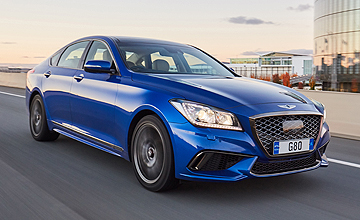
Overview
In late 2014, Hyundai launched the Genesis large sedan, the flagship of the local passenger car range and the precursor to the introduction of Genesis as a standalone brand.
Fast forward to mid-2019, and the Genesis marque has finally landed Down Under, with the Genesis sedan – now renamed G80 – representing the flagship for the two-model range.
With a slight trend upwards in price, the G80 range has also been updated lightly with some additions to specification and slight mechanical alterations.
Given Australian customers have a dwindling appetite for large luxury sedans, does the G80 have what it takes to lure buyers to the Genesis brand?
Drive impressions
The new Genesis range consists of the G70 medium sedan and G80, the latter of which found favour with businesses and fleets as the Hyundai Genesis due to its strong value proposition and suitability as a chauffeur car.
A strong comfort oriented, limousine-type ethos has carried over to the current G80, with a greater emphasis on a luxurious driving experience than a dynamically engaging drive.
Entering the cabin for the first time, that mantra is clear with beautifully soft quilted leather upholstery and wonderful suede headliner for Ultimate variants, alongside heated and ventilated seats.
The generous amounts of wood trim also match well with the leather interior, particularly when optioning either the beige or brown interior hue.
Unfortunately, the image of luxury is broken up by the G80’s switchgear, with cheap, black plastic buttons adorned with lettering that uses the same font as Hyundai’s vehicles.
This could be easily remedied by Genesis with a switch to either a gloss-black or aluminium-look material, and a change of font would remove any association with Hyundai.
The G80’s 9.2-inch infotainment system is also lifted from Hyundai, and while there is nothing wrong with the system, it does slightly detract from the overall premium feel of the interior.
One disappointing aspect of the G80’s infotainment system is the lack of DAB+ digital radio, which strangely is standard on the G70 but not on the flagship model.
We also think the G80’s infotainment would benefit from a BMW iDrive-style controller, as the screen is quite far away from the driver and requires some reaching to play with.
However, by and large, the G80 cabin is a serene place to be, with excellent noise suppression thanks in part to its acoustic laminated glass and exhaust system, leading to a relaxing and whisper-quiet driving experience for all occupants.
As a large sedan, legroom is plentiful for both front and rear passengers, a necessary feature for those planning to use their G80 as a taxi or limousine service.
Rear passengers are treated to a central control unit that can manipulate the position of the seat in front, sliding of their own rear seat and audio and air-conditioning controls.
While rear legroom is more than ample, we would have liked to have seen greater headroom, as our 186cm frame could feel the roof line against our hair.
The G80’s interior aims to make the drive experience as comfortable as possible, which works in tandem with the suspension system that has been calibrated for a superbly comfortable and plush ride quality.
Like other Hyundai Motor Group models, Australian versions are subjected to a local suspension tune to deal with our harsh road conditions, and Genesis engineers have done a bang-up job of ensuring a comfortable ride with the G80.
It employs the Genesis Adaptive Control Suspension system, which uses electronic control suspension and adaptive damping that helps smooth out bumps and road imperfections with ease.
The suspension system also helps minimise body roll around corners – a difficult task given the G80 measures 4990mm long and tips the scales at 1985kg.
Given the large dimensions of the G80, it is not quite a dynamic masterpiece, but still does an admirable job of feeling engaging through corners, with its rear-drive layout helping prevent understeer and ensuring the car stays pointed in the direction you want it to go.
Only one engine choice is available for the G80 range, which, as before, is a 3.8-litre aspirated V6 petrol engine producing 232kW at 6000rpm and 397Nm at 5000rpm, driving the rear wheels via an eight-speed automatic transmission.
While power outputs remain unchanged over the existing model, Genesis has worked on reducing weight from the engine which has reduced fuel consumption by 0.8 litres per 100km to 10.4-10.8L/100km, depending on the variant.
The V6 unit is well suited to the G80, with a smooth, inoffensive driving character and a muted exhaust note that ensures minimal noise intrusion into the cabin.
Performance is respectable, with the G80 able to get up to speed easily when sticking the boot in.
The eight-speed auto is also well calibrated, shifting sensibly and largely going unnoticed when driving, which is generally considered a good thing.
It is unfortunate that the 3.8 engine is the only powertrain on offer, as international markets offer the 3.3-litre twin-turbo V6 producing 272kW/510Nm, which is not made in right-hand-drive production.
The punchier V6 would do well in the G80, and increase the appeal of the model for those who will be driving as opposed to being driven.
In our time with the G80 we recorded a fuel economy figure of around 11.5L/100km, not far off the official figure.
Overall Genesis is offering a strong value proposition for the G80. Those who prioritise space, specification and comfort need look no further; however, it is not without its faults.
Engine choice would be welcome, and its age and Hyundai underpinnings are a little too evident.
With the G80 only expected to make up around 20 per cent of overall Genesis sales, it is not expected to be a volume seller for the brand, however it makes for a solid flagship model – until the arrival of all-new product, expected to land here in coming years.